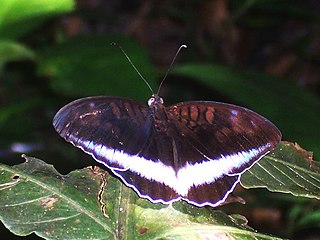
Swallowtail butterflies are large, colorful butterflies in the family Papilionidae, and include over 550 species. Though the majority are tropical, members of the family inhabit every continent except Antarctica. The family includes the largest butterflies in the world, the birdwing butterflies of the genus Ornithoptera.

The owl butterflies are species of the genus Caligo and are known for their huge eyespots, which resemble owls' eyes. They are found in the rainforests and secondary forests of Mexico, Central and South America.

Graphium is a genus of mostly tropical swallowtail butterflies commonly known as swordtails, kite swallowtails, or ladies. Native to Eurasia, Africa, and Oceania, the genus is represented by over 100 species. Their colouration is as variable as the habitats they frequent; from rainforest to savannah. Some possess tails which may be long and swordlike, while others lack any hindwing extensions. Graphium species are often sighted at mud puddles.

Otto Staudinger was a German entomologist and a natural history dealer considered one of the largest in the world specialising in the collection and sale of insects to museums, scientific institutions, and individuals.

The Limenitidinae are a subfamily of butterflies that includes the admirals and relatives. The common names of many species and genera reference military ranks or – namely the Adoliadini – titles of nobility, in reference to these butterflies' large size, bold patterns, and dashing flight. In particular, the light stripe running lengthwise across the wings of many Limenitidini has reminded earlier authors of officers' shoulder marks and epaulets.

Acontiinae is a subfamily of bird dropping moths in the family Noctuidae. There are more than 50 genera and 430 described species in Acontiinae, found worldwide in temperate and tropical climates.

Archon is a genus of Palaearctic swallowtail butterflies in the subfamily Parnassiinae. Traditionally, only two species have been recognized: Archon apollinus and Archon apollinaris. Recent studies, however, have given specific status to a third taxon, Archon bostanchii, and suggested that further subspecies could warrant recognition as species.

Zerynthia is a genus of swallowtail butterflies placed in the subfamily Parnassiinae. The genus has a complex history; a multiplicity of names have been applied to its species.

Axia, the gold moths, is a genus of moths whose precise relationships within the macrolepidoptera are currently uncertain, but they currently are placed within the superfamily Drepanoidea. Uniquely, they have a pair of pocket-like organs on the seventh abdominal spiracle of the adult moth which are possibly sound receptive organs. They are quite large and brightly coloured moths that occur only in southern Europe and feed on species of Euphorbia. Sometimes they are attracted to light. The genus was first described by Jacob Hübner in 1821.

Hadenini is a tribe of cutworm or dart moths in the family Noctuidae. There are more than 140 genera and 1,000 described species in Hadenini, found worldwide.

Parides, commonly called cattlehearts, is a genus of swallowtail butterflies in the family Papilionidae. They are found in the Americas.
Archon bostanchii is a species of false Apollo butterfly belonging to the Parnassiinae or snow Apollo subfamily. This papilionid is endemic to Iran. It was originally described as a subspecies of Archon apollinaris but subsequently recognized as a full species.

Allancastria louristana is a butterfly belonging to the family Papilionidae. It is found only in western Iran.

Allancastria deyrollei is a butterfly belonging to the family Papilionidae. It was described by Oberthür in 1869 as a variety then a subspecies of Allancastria cerisyi see that species for the differentiation. It is found only in western Iran, Turkey, Syria, northwestern Iraq, Lebanon, Jordan, and Israel.

Drasteria is a genus of moths in the family Erebidae.

Lygephila is a genus of moths in the family Erebidae. The genus was erected by Gustaf Johan Billberg in 1820.

Streblote is a genus of moths in the family Lasiocampidae. It was described by Jacob Hübner in 1820.

Rhodometra is a genus of moths in the family Geometridae erected by Edward Meyrick in 1892.

Dyspessa is a genus of moths belonging to the family Cossidae. It was described by Jacob Hübner in 1820.

Taenaris is a genus of butterflies in the family Nymphalidae, subfamily Amathusiinae, that distributed throughout Australasia with a majority of species being located on the island of New Guinea. They are commonly known as the owl butterflies.



















